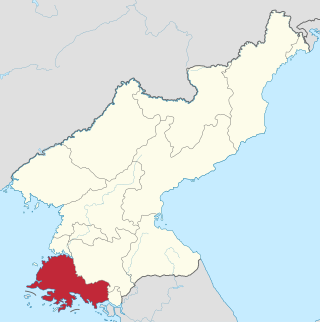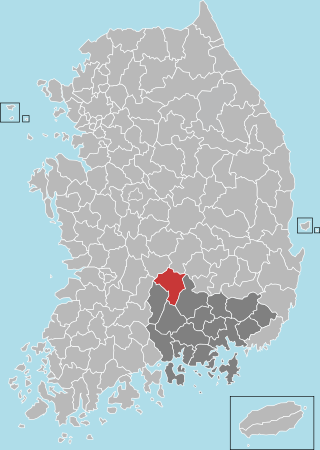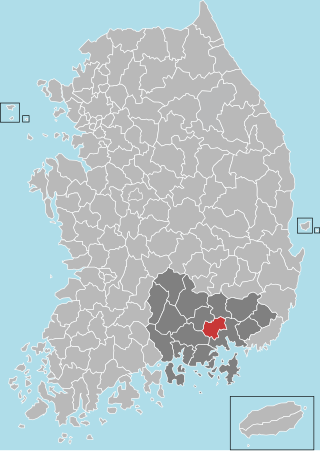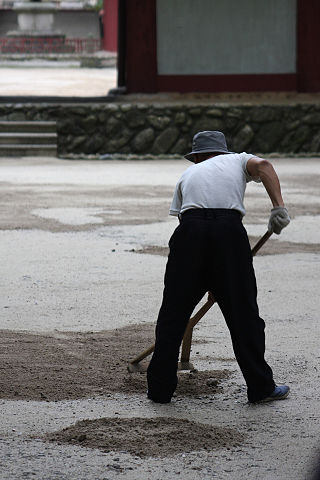
South Hwanghae Province is a province in western North Korea. The province was formed in 1954 when the former Hwanghae Province was split into North and South Hwanghae. The provincial capital is Haeju.

North Hwanghae Province is a province of North Korea. The province was formed in 1954 when the former Hwanghae Province was split into North and South Hwanghae. The provincial capital is Sariwon. The province is bordered by Pyongyang and South Pyongan to the north, Kangwon to the east, Kaesong Industrial Region and South Korea's Gyeonggi Province to the south, and South Hwanghae southwest. In 2003, Kaesong Directly Governed City became part of North Hwanghae as Kaepung County. Later on in 2019, it was promoted as Special City. Thus, it was separated from North Hwanghae.

Kaesong is a special city in the southern part of North Korea, and the capital of Korea during the Taebong kingdom and subsequent Goryeo dynasty. The city is near the Kaesong Industrial Region close to the border with South Korea and contains the remains of the Manwoldae palace. Called Songdo while it was the ancient capital of Goryeo, the city prospered as a trade centre that produced Korean ginseng. Kaesong now functions as North Korea's light industry centre.

Samcheok is a city in Gangwon-do, South Korea.

Wanju County (Wanju-gun) is a county in North Jeolla Province, South Korea. It almost entirely surrounds Jeonju. This county should not be confused with Wonju, in Gangwon-do.

Goguryeo tombs, officially designated as the Complex of Koguryo Tombs, are tombs in North Korea. In July 2004, they became the first UNESCO World Heritage site in the country. The site consists of 30 individual tombs from the later Goguryeo kingdom, one of Three Kingdoms of Korea, located in the cities of P'yŏngyang and Namp'o. Goguryeo was one of the strongest ancient Korean kingdoms located in the northern and central parts of the Korean Peninsula and the southern and central parts of Manchuria. The kingdom was founded in the present day area of North Korea, and part of Manchuria around 37 BCE, and the capital was transferred to P'yŏngyang in 427 CE.

Anak Tomb No. 3 is a chamber tomb of Goguryeo located in Anak, South Hwanghae, North Korea. It is known for mural paintings and an epitaph. It is part of the Complex of Koguryo Tombs.

Namyangju is a city in Gyeonggi Province, South Korea. To the east is Gapyeong County, to the west is Guri City, and to the north is Pocheon City. Namyangju-si was originally a southern part of Yangju-gun, but was separated into Namyangju-gun in April 1980. In 1995, Migeum-si and Namyangju-gun were merged to form an urban and rural complex. The city hall is located in Geumgok-dong and Dasan-dong, and the administrative districts are 6-eup, 3-myeon, and 7-dong.

Geochang County is a county in South Gyeongsang Province, South Korea. The Geochang International Festival of Theater, which was started in 1989, is renowned as the best play festival in Korea. The District Office is located in Geochang-eup, and has jurisdiction over 1 eup and 11 myeon.

Haman County (Haman-gun) is a county in South Gyeongsang Province, South Korea. The local government is seated in Gaya-eup. The county magistrate is Seok Gyu Jin.

Haeju is a city located in South Hwanghae Province near Haeju Bay in North Korea. It is the administrative centre of South Hwanghae Province. As of 2008, the population of the city is estimated to be 273,300. At the beginning of the 20th century, it became a strategic port in Sino-Korean trade. Haeju has chemical-related enterprises and a cement factory.
Hamchang is an eup in Sangju City, North Gyeongsang province, South Korea. It comprises 30 distinct ri, and has a population of 8,427. There are two elementary schools, a middle school and a high school. Hamchang was once the capital of a small kingdom, Goryeong Gaya. Although its role today is far less central, it remains an important local town, served by intercity buses as well as the Gyeongbuk Line railroad.
Kuwŏlsan, or Mount Kuwol, is a mountain in South Hwanghae, North Korea. The mountain takes its name from the ninth month of the lunar calendar, because it is considered particularly attractive in that month. The mountain is a major summer resort in North Korea, attracting many domestic tourists.

Unsan County is a kun, or county, in eastern North P'yŏngan province, North Korea. Within the province, it borders Hyangsan in the east, Kujang and Nyŏngbyŏn in the south, and Tongch'ang and T'aech'ŏn in the west. In addition, it is bordered by Chagang province to the east (Hŭich'ŏn) and north (Songwŏn).

The Tomb of King Dongmyeong, also known as the Tomb of King Tongmyŏng, is a mausoleum located in near Ryongsan Village, Ryokpo-guyok, Pyongyang, North Korea. One of the tombs is the royal tomb of Dongmyeong, the founder of the ancient Goguryeo Kingdom, northernmost of the Three Kingdoms of Korea. In total, there are 63 individual tombs of the period. The area around Dongmyeong contains at least fifteen known tombs believed to belong to various vassal lords. The tomb has achieved World Heritage status as part of the Complex of Goguryeo Tombs inscribed by UNESCO in 2004 under Criteria (i), (ii), (iii) and (iv) covering an area of 233 hectares with a buffer zone of 1,701 hectares. A unique feature of it and the other extant tombs in the area are the wall paintings depicting blossoming lotuses, indicative of Buddhism practiced and perhaps prevalent in Korea around 277 BC to 668 AD.

Chaeryŏng County is a county in South Hwanghae province, North Korea.

Songhwa County is a county in South Hwanghae province, North Korea.

Ulju County is a county occupying much of western Ulsan, South Korea.

"Hwanghae Province" or "Hwanghae-do" is, according to South Korean law, a province of the Republic of Korea, as the South Korean government formally claims to be the legitimate government of whole of Korea. The area constituting the province is under the de facto jurisdiction of North Korea.

The Anak Woljongsa is an historic Buddhist temple, one of the National Treasures of North Korea (#75). It is located in Woljong-ni, Anak County, South Hwanghae Province. It is located near Mt. Kuwol.


















